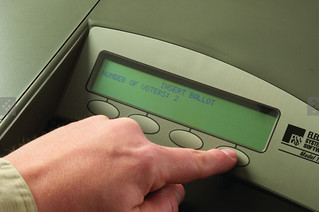 You’ve probably noticed that just about every news article on what’s about to happen with the Virginia Attorney General’s race has referred to a “recount.” But after talking to Ben “Not Larry Sabato” Tribbett last night, I’m convinced that this is at least somewhat misleading. In fact, as Ben explained, potentially many thousands (he estimates 25,000-50,000) of “undervotes” (e.g., in which a vote was not recorded, for whatever reason, for Attorney General) – plus potentially thousands more “overvotes” (e.g., in which a voter appeared to have voted for both candidates in the AG race) – have not yet been counted the FIRST time. So…instead of being a pure “recount,” the following few weeks will actually see the FIRST count of many ballots in Virginia, namely those that couldn’t be read the first time (for a variety of reasons) by optical scan machines (note that VPAP estimates “712,000 of those ballots were cast statewide this year.”).
You’ve probably noticed that just about every news article on what’s about to happen with the Virginia Attorney General’s race has referred to a “recount.” But after talking to Ben “Not Larry Sabato” Tribbett last night, I’m convinced that this is at least somewhat misleading. In fact, as Ben explained, potentially many thousands (he estimates 25,000-50,000) of “undervotes” (e.g., in which a vote was not recorded, for whatever reason, for Attorney General) – plus potentially thousands more “overvotes” (e.g., in which a voter appeared to have voted for both candidates in the AG race) – have not yet been counted the FIRST time. So…instead of being a pure “recount,” the following few weeks will actually see the FIRST count of many ballots in Virginia, namely those that couldn’t be read the first time (for a variety of reasons) by optical scan machines (note that VPAP estimates “712,000 of those ballots were cast statewide this year.”).
For more on procedures for optical scan machines, which are the main issue here with regard to possible “undervotes” and “overvotes,” see the Code of Virginia. Here’s the key part:
For optical scan tabulators, the recount officials shall rerun all the ballots through a tabulator programmed to count only the votes for the office or issue in question in the recount and to set aside all ballots containing write-in votes, overvotes, and undervotes. The ballots that are set aside, any ballots not accepted by the tabulator, and any ballots for which a tabulator could not be programmed to meet the programming requirements of this subdivision, shall be hand counted…
Another question Ben and I discussed was whether the optical scan machines did what they’re supposed to do in the first place, which would be to reject any “votes” not clearly marked, so that they could have been either an “overvote” or an “undervote.” On the “overvote,” an example would be someone filling in the bubble for Herring, then realizing they meant to vote for Obenshain, so they crossed out the Herring bubble and filled in the Obenshain bubble, even circling it to make clear that they mean to vote for Obenshain. The machine should have rejected that as an “overvote” – a vote for both Herring and Obenshain – since it’s not “smart” enough to determine what’s going on in that case. That will take a human being, and that has not happened yet – and won’t until the inaptly-named “recount” takes place. Of course, if the machines mistakenly counted “overvotes” and/or “undervotes,” then we’ve got even more issues to deal with.
Anyway, the bottom line is that there are thousands of ballots where – for a variety of reasons – the optical scan machines might not have been able to determine the intent of the voter. In those cases, what’s supposed to happen in the “recount” is that these ballots will be examined by human beings to determine what the voter’s intent was. For instance, if a bubble was marked for Obenshain, but not darkly enough for the machine to read, that’s obviously a vote for Obenshain. Or, if someone marked an “x” through the bubble for Herring and the machine couldn’t read it, that would clearly be a vote for Herring. Etc, etc. These are determinations that, in the end, only human beings – not machines – can make. And they haven’t been made previously, so again this isn’t a “recount” of those ballots, it’s a FIRST count of ballots that had not been counted previously (at least for the races in which there were “undervotes” or “overvotes”).
If you’re curious which jurisdictions in Virginia use which types of voting systems, see here. Note that WINVote and WINScan are touch screen machines; AccuVote-OS are optical scanners, as are M100 scanners/tabulators, the OPTECH IIIP-Eagle machine, etc. Also note that many of these machines (e.g., the M100) claim that they “[return] over-voted, under-voted and blank ballots while the LCD touch screen displays the race in question.” We’ll see soon enough if that worked as it was supposed to.
So what impact might all of this have on the Attorney General’s race? It’s hard to say. I looked into the rates of “undervotes” in other states and found a wide variance. For instance, this article reported that the Georgia Secretary of State “found that undervotes (the difference between the number of actual ballots cast and the number of votes recorded in final certified results) in the presidential race showed a statewide mean average of 4.4%,” with “[t]he mean averages of counties aggregated by voting equipment…Punch Card: 4.6%, Optical Scan: 4.5% and Lever Machine: 4.2%.” If that’s the case in Virginia, that could imply around 4.5% times 28k (the lower number of votes cast for AG than for Governor) is around 1,260 votes total. (Actually, Ben pointed out to me that the number could be higher than 28k, because there could have been numerous people who didn’t vote for governor for whatever reason – disliked all the candidates? – but DID attempt to vote for Attorney General) For Obenshain to overtake Herring’s 165-vote lead, he’d have to win those 1,260 votes at a 57%-43% clip (713-547), which seems highly unlikely to occur.
In contrast, this article refers to a miniscule “0.12% rate of undervotes” by optical scanners in Florida in 2004. That would imply as few as 336 undervotes in Virginia on November 5. With Mark Herring leading by 165 votes, that would require Obenshain to win those 336 undervotes by a huge margin (251-85) to overtake Herring. And that’s highly, highly improbable.
Perhaps the performance of optical scan machines in Virginia will vary widely by make, model, and condition of the machines? For instance, a knowledgeable person in Fairfax County told me that that county’s optical scan machines “were bought used and are really ‘cranky’, so {there may be} LOTS of undervotes and overvotes” – on the order of 2,000+ in Fairfax County alone. Assuming these votes broke the same way the overall vote did on November 5 – approximately 61%-39% for Mark Herring – then this would imply a net gain for Herring of perhaps 400 votes or so in Fairfax County. Of course, as my Fairfax County source points out, how high or low this number is might very well come down to who’s making the determination, ballot by ballot, particularly on really close calls.
Again, though, it’s important to emphasize that none of the votes should have been counted previously, as they should have been rejected as unreadable and/or indecipherable by the optical scan machines. So, the bottom line is that to the extent we’re talking about optical scan machines, at least, what we’ll be seeing over the next few weeks is only partly a “recount” (in which the ballots are fed back through the machines, after the machines are properly calibrated) and partly a “new count” (in which votes that have never been counted before now can be counted by human beings using their judgment). It should be fascinating, although in the end my guess is that this process won’t change the result, other than perhaps adding to Mark Herring’s lead in places like Fairfax County. Stay tuned…
P.S. Also note that for touch-screen machines, there’s no real way to “recount” them (totals will simply be added up again), so this isn’t really a pure “recount” we’re going to be seeing.
P.P.S. In the case of provisional and absentee ballots, they actually WILL be recounted by hand.



![Video: Former Eastern District of VA Federal Prosecutor Gene Rossi Asks, “Is Donald Trump going to be the lead counsel in that prosecution [of Jim Comey] and do the opening, closing and rebuttal? I pray that he does!”](https://bluevirginia.us/wp-content/uploads/2025/09/rossiedva-238x178.jpg)








![Saturday News: “Trump’s latest tariff TACO probably won’t make your life more affordable”; “The Epstein Email Cache: 2,300 Messages, Many of Which Mention Trump”; “[MTG] questions if Trump is still the ‘America First’ president”; “Jim Ryan tells all: ‘What did the Governor know, when did he know it?’”](https://bluevirginia.us/wp-content/uploads/2025/11/montage1115-100x75.jpg)
